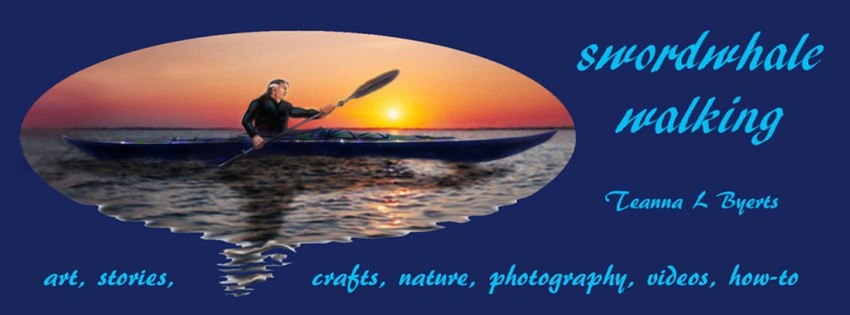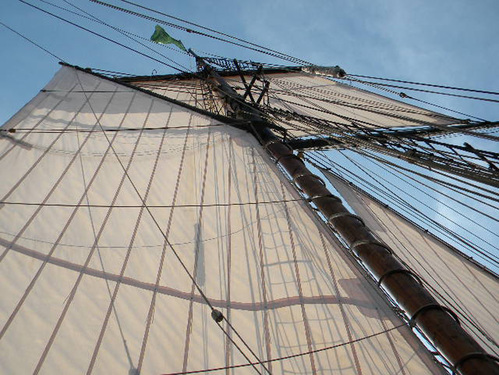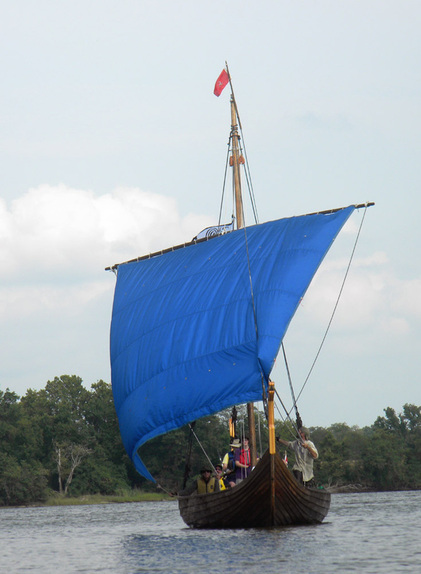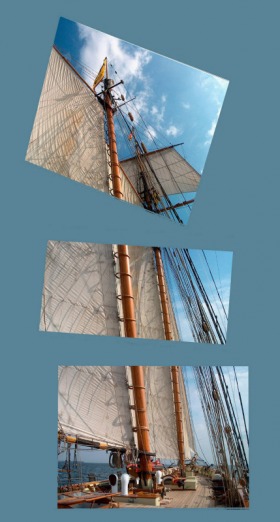Sailing 101
how to survive being a Viking, Privateer, or other Guest Sailor for a day
The Susquehanna River runs through my world, flows south over ancient Native Petroglyphs, modern dams, past farms and highly developed areas and into the wide reaches of the Chesapeake Bay. It is a water world full of American history, the Revolution, the War of 1812, John Smith's exploration of the Bay in a tiny shallop, the Kalmar Nyckel bringing the first settlers to "New Sweden" (Wilmington DE), pirates and British fleets and rockets red glare and ...
...yes, that's a Viking longship. No, as far as we know Vikings (a job description and a verb, not a culture, that would be the Norse) got no farther than L'Anse aux Meadows in Newfoundland Canada. http://www.mnh.si.edu/vikings/1137.html
You can, however, do your own experimental archaeology along with the Longship Company at Oakley Maryland (free, we need crew), or hitch a ride on one of the other historic reproduction tall ships scattered around the Chesapeake and Delaware Bays.
Here's what you need...
Absolutely zero experience. These tall ships are set up as educational platforms, floating classrooms, adventure for a day experiences. Most charge a fee (ranging from $25 to $60) for a sail of a couple hours. Some have age restrictions: no one under five, or all under 12 must wear PFD at all times. Most are accessible to people of varied physical abilities, though on most ships, the head is down a steep gangway ladder belowdecks. Most are participatory, you will be invited to help raise the sails, or steer as conditions (and your own wishes) permit.
A camera. You'll want to take pics, lots of pics, or shoot video. You don't need anything really fancy, but something better than your measly cell phone would be good.
PFDs.... are aboard the ship already. If they are taking passengers, they are prepared for any emergency. The crew will give you the "pre-flight disaster plan speech" usually with great good humor. I've never been on one that sank. Most ships have a lot of freeboard (high off the water) and railings. While I did lose a mighty fine Schooner Sultana hat in the middle of the Chesapeake Bay once (leaning over to take a picture), it's quite hard to fall overboard. And they have rescue plans.
Snacks and water. Bring lots, especially if it is hot. Water is sometimes available on the ship. Some, like the Woodwind, offer snacks for sale (it helps keep the ship sailing). Most don't like glass containers (it breaks and wreaks havoc). Small coolers are usually welcome, as are backpacks or other smallish bags for your stuff. Booze, not so much.
No smoking. Most of these ships are wood ('nuff said). Most of these folks are out for a good time, they do not want to breathe your pollution.
Look, up in the sky, it's... the sun. Lots of sun. You are on a ship, there is no shade (unless you briefly get in the shadow of a sail). Bring a hat, sunglasses, sunscreen, clothing, light colors that shed heat, clothes that are comfy and cool. Those rash-guard surfer shirts are great 100 proof sunscreen.
BRRRRRRRR!! (checks thermometer) I thought they said it was going to be 72 today.... it is, on land. You are on a boat, in the middle of the water. The fact that the boat has sails should be a clue... IT'S WINDY OUT THERE! This may drop that comfy land temperature to a shivery chill. Bring a pack with a few extra layers; fleece, windbreaker, hat. In colder weather add wool, heavier fleeces, puffy vests. Stuff that works when wet is best. Most ships are pretty dry, but you never know when it might rain, or you might actually feel the spray in your face, and all over your cotton shirt. Remember: on the water, cotton is rotten. Use quick dry materials like that spandex superhero sporty stuff, fleeces, wool, windbreakers.
Your own logbook. A sketchbook, notebook or other way of logging interesting info is useful... especially when trying to remember just what they were doing with that sail you took a picture of. Using the video mode on your camera is another way to take notes quickly.
Ditch the screens. The point is to feel the waves, hear the creak of the hull, the singing of the wind in the rigging, the high screeee of gulls, to watch the sails shapeshift under the wind, to leap the waves, to journey back in time, to smell the salt air, to hold the tiller and feel the waves slide past the rudder, to catch a sudden glimpse of something surfacing from the deep. Unplug your kids and leave their electronic crap in the car. Lose the ipod. Most ships will (as a safety concern) make sure at least one ear is tuned to the crew's orders (it may be a matter of life and death for you to hear a command). Anyway, you are here for this experience, BE... HERE... NOW!
You can, however, do your own experimental archaeology along with the Longship Company at Oakley Maryland (free, we need crew), or hitch a ride on one of the other historic reproduction tall ships scattered around the Chesapeake and Delaware Bays.
Here's what you need...
Absolutely zero experience. These tall ships are set up as educational platforms, floating classrooms, adventure for a day experiences. Most charge a fee (ranging from $25 to $60) for a sail of a couple hours. Some have age restrictions: no one under five, or all under 12 must wear PFD at all times. Most are accessible to people of varied physical abilities, though on most ships, the head is down a steep gangway ladder belowdecks. Most are participatory, you will be invited to help raise the sails, or steer as conditions (and your own wishes) permit.
A camera. You'll want to take pics, lots of pics, or shoot video. You don't need anything really fancy, but something better than your measly cell phone would be good.
PFDs.... are aboard the ship already. If they are taking passengers, they are prepared for any emergency. The crew will give you the "pre-flight disaster plan speech" usually with great good humor. I've never been on one that sank. Most ships have a lot of freeboard (high off the water) and railings. While I did lose a mighty fine Schooner Sultana hat in the middle of the Chesapeake Bay once (leaning over to take a picture), it's quite hard to fall overboard. And they have rescue plans.
Snacks and water. Bring lots, especially if it is hot. Water is sometimes available on the ship. Some, like the Woodwind, offer snacks for sale (it helps keep the ship sailing). Most don't like glass containers (it breaks and wreaks havoc). Small coolers are usually welcome, as are backpacks or other smallish bags for your stuff. Booze, not so much.
No smoking. Most of these ships are wood ('nuff said). Most of these folks are out for a good time, they do not want to breathe your pollution.
Look, up in the sky, it's... the sun. Lots of sun. You are on a ship, there is no shade (unless you briefly get in the shadow of a sail). Bring a hat, sunglasses, sunscreen, clothing, light colors that shed heat, clothes that are comfy and cool. Those rash-guard surfer shirts are great 100 proof sunscreen.
BRRRRRRRR!! (checks thermometer) I thought they said it was going to be 72 today.... it is, on land. You are on a boat, in the middle of the water. The fact that the boat has sails should be a clue... IT'S WINDY OUT THERE! This may drop that comfy land temperature to a shivery chill. Bring a pack with a few extra layers; fleece, windbreaker, hat. In colder weather add wool, heavier fleeces, puffy vests. Stuff that works when wet is best. Most ships are pretty dry, but you never know when it might rain, or you might actually feel the spray in your face, and all over your cotton shirt. Remember: on the water, cotton is rotten. Use quick dry materials like that spandex superhero sporty stuff, fleeces, wool, windbreakers.
Your own logbook. A sketchbook, notebook or other way of logging interesting info is useful... especially when trying to remember just what they were doing with that sail you took a picture of. Using the video mode on your camera is another way to take notes quickly.
Ditch the screens. The point is to feel the waves, hear the creak of the hull, the singing of the wind in the rigging, the high screeee of gulls, to watch the sails shapeshift under the wind, to leap the waves, to journey back in time, to smell the salt air, to hold the tiller and feel the waves slide past the rudder, to catch a sudden glimpse of something surfacing from the deep. Unplug your kids and leave their electronic crap in the car. Lose the ipod. Most ships will (as a safety concern) make sure at least one ear is tuned to the crew's orders (it may be a matter of life and death for you to hear a command). Anyway, you are here for this experience, BE... HERE... NOW!
Want to sound like a sailor? Talk like a pirate? Here are a few useful sites:
Sailing 101, beam reaches, goosenecks, and clap'er in irons. Fun! http://www.sailorgirl.com/s/inx_sailing101.htm
Talk like a pirate: http://www.sailorgirl.com/s/v4-03_piratetalk.htm
Go to sea with Master and Commander of the novel of the Age of Fighting Sail: (cool stuff about sailing in the early 19th century) http://www.patrickobrian.com/
A field guide to tall ships (a good sailor, like a good birder, could tell you a great deal about a ship when it was but a blit on the horizon). http://www.boston.com/interactive/graphics/200907_tallshipsguide/
and... http://nauticaltraditions.com/Media/How%20Tall%20is%20Tall.pdf
Talk like a pirate: http://www.sailorgirl.com/s/v4-03_piratetalk.htm
Go to sea with Master and Commander of the novel of the Age of Fighting Sail: (cool stuff about sailing in the early 19th century) http://www.patrickobrian.com/
A field guide to tall ships (a good sailor, like a good birder, could tell you a great deal about a ship when it was but a blit on the horizon). http://www.boston.com/interactive/graphics/200907_tallshipsguide/
and... http://nauticaltraditions.com/Media/How%20Tall%20is%20Tall.pdf




